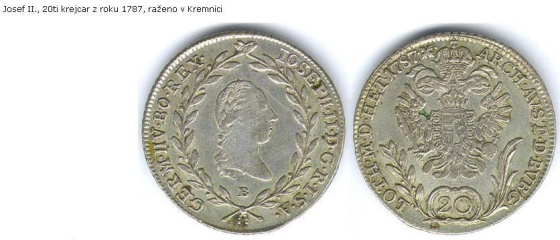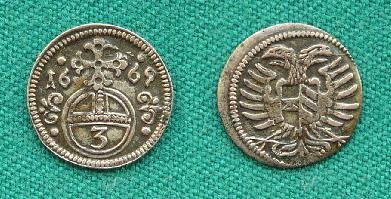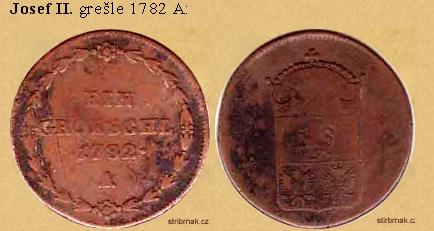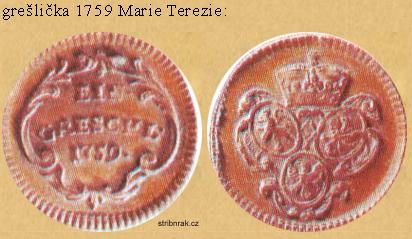pěknej a poučnej článek !
History of coins - Tronic, Grešle, Krejcar
Categories: Minting - Numismatics
The triangle is a silver coin with a diameter of 15-16 mm and a weight of 0.5- 0.6 g. The obverse depicts the imperial eagle with the Austrian-Burgundian shield on its chest. On the reverse is stamped an imperial apple with the value of the coin, the year of the auction, divided into two parts by the imperial apple. Both sides are framed by a pearl, which is formed by oval lines, set densely side by side and pointing to the centre of the coin. Originally, there were four triplets per groschen (= three kreutzers). Later, the designation of small coins in general (especially the half-crejectare). The saying "to go to the Kremlin for trochees" is an expression of failure, unprofitability of business.
It is also known that gold triplets were minted in 1668, 1690, 1693, 1696, 1699, which are stored in the Wroclaw Museum, where there are also approximately 130 silver triplets, most of which are rarities. The weight of a gold bullet is about 1.13 grams.
The triplets were minted in Opole (1688-1704), Brzeg (1693-1697) and Wrocław (1705). The production was interrupted in 1675-1678, 1684-1685, 1698, 1701-1702.
The triple is pejoratively called grešli. From 1559 onwards, the small German coins 1 thaler = 84 gresls were called gresls. In Bohemia, this name came into use only during the reign of Ferdinand II in 1624, when a coin with a diameter of 16.4 mm and a weight of 0.73 g was minted in Silesia. It was colloquially referred to as the Troika. Minting continued during the reign of Ferdinand III, the end of the mintage came with the accession of Joseph II to the throne.
For Christmas 1623, a particularly generous gift came from His Imperial Grace: a calade. It is a word that comes from the Italian calata and means descent, decline, falling. In this case, it is a coinage calade, which represents the largest state bankruptcy in Czech history. The value of the currency has fallen by an average of 90%. During the Thirty Years' War, the currency was further devalued. The grain was reduced, the face value increased, the number of pieces minted from the hryvnia increased and the silver content fell to a fraction of its original value. The result was the so-called "long coin". It was so called because one had to count for a long time before one could calculate the original value.
A major monetary reform was carried out in 1754 by Maria Theresa, when she announced a new monetary system that was then in force for a hundred years.
The monetary system looked like this:
1 Vienna hryvnia = 12 thalers
= 24 half dollars
= 48 quarter dollars
= 72 twenties
= 84 12/17 seventeen
= 144 dimes
= 205 5/7 seventhsk's
= 480 groschen
= 1,800 kreutzers
= 2,400 groschen
= 3,600 half kreutzers
= 8,640 Vienna pennies (pfennigs)
During her reign and that of her son Joseph II, coins began to be minted not from precious metal but from copper. It was the grešle and became part of the monetary system. Later, in the 1850s, the Prague mint even minted the grešlička, an even less valuable and also really small coin, only one and a half grams. The names grešlička and grešle, and the derived držgrešle, are interesting mainly because the CzechGerman, where the coin was called Greschel, which was a diminutive of Groschen, and the German word was in turn adopted from the Czech. However, the Czech groschen, a word made famous by the very valuable Prague groschen in its time, is not originally Czech either.
The Czechs named their penny after a coin minted in the 13th century by the French ruler Louis IX, which was called denarius grossus, i.e. a heavy, thick denarius in Latin.
In the 1760s, Maria Theresa had other small coins, kreuzers, grecs, half kreuzers and pfennigs, made of copper, replacing the real value of the metal with a mere symbol. This gave rise to the first credit money. In 1762, the Bank of Vienna issued the first paper money in denominations of 5, 10, 25, 50 and 100 gold pieces, called bankocetle after the original inscription on the money: Wiener - Stadt - Banco - Zettel.
The Krejcar was a silver coin of German origin which took its name from the cross engraved on it. It was first minted in Tyrol before 1496, later elsewhere, and in 1561 it entered the Bohemian coinage. Values 2 kr, 10 kr, 30 kr and 60 kr (1 imperial gold piece). As the customary counting into thalers and groszys had thus far taken over, there was a dislike for this currency and it was abolished in 1573 and only reintroduced in 1619 in the values of 3 kr, 12 kr and 24 kr. The Krejcar was still minted under Maria Theresa, and in 1760 it was first minted as a copper coin, which underwent many changes in its diameter and thickness.

The next state crash came in 1811, when an 80 percent bankruptcy was declared, which meant that a 100 gold banknote was worth only 20 gold pieces. The coins were then devalued at a ratio of 1:5 and the finest coins were taken out of circulation.
The gresle was always a very small coin with little value. And it gave rise to the popular saying, "It's not worth a broken pretzel."
Do you want to find a historical coin too? Check out our metal detectors.
Teisinger, H.: LEOPOLD I- TROJNIKES BY YEARS AND VARIATIONS
stribrnak.cz, mujweb.atlas.cz,
The article is included in categories:
Post
pěknej a poučnej článek !
Pěknej článek.
Super čtení , někde na mě čekají , kolečka zakutálený .
SUPER ČTENÍ!
SUPER ČTENÍ!
Já jsem jednu grešli Marušky Terezky nedávno našel  Není ale bohužel v nejlepším stavu
Není ale bohužel v nejlepším stavu  Nicméně udělalo mi to radost jako kdybych našel kilo zlata
Nicméně udělalo mi to radost jako kdybych našel kilo zlata 
JJ--)) Já jsem dnes našel asi ten trojník ..z jedné strany totálně sešoupanej..z druhé jde trošku vdět ten kříž a jabko--))
hezkej ton..no nekopte to..akorát ten stav nic moc..
Mám ročník 1624..ten byl ražen kde?
Děkuji za odpověď
To Cortes: S největší pravděpodobností máš ražbu z vratislavské mincovny, ovšem z období vlády Ferdinanda II. (1617 - 1637). Ty se v rámci nejstarších grešlí vyskytují nejčastěji. Některé mívají po stranách orla drobnou zkratu H-R, což jsou iniciály vratislavského mincmistra Hieronyma Riedela.
Jinak si dovolím přidat tady v komentáři něco málo doplňků k tomuto článku:
Ražba grešlí za vlády Leopolda I. v mincovně Opole probíhala v letech 1668 - 1674, 1679 - 1684, 1686 - 1697, 1699, 1703 - 1704 a v mincovně Břeh v letech 1693 - 1697 a 1702. Co se týče jejich výskytu, tak obecně patří (podobně jako Leopoldovy krejcary a 3krejcary) mezi poměrně často nalézané drobné mince, vzácné jsou pouze některé ročníky (Opole 1672, 1674, 1683, 1684, 1692 a 1699; Břeh 1702) a také některé varianty ročníků a pak samozřejmě ony zmíněné zlaté odražky.
HAndreas----Díky za určení--))
Vyborny clanek,konecma jeden jasno jak to s tou menou bylo,diky.
Když můj kluk kopnul svoje první kolečko Greschl 1760 do mojí sbírky, nevěděl jsem přesně historii-díky.
ja jsem našel asi tak před měsícem krejcar 1760 Marie Terezie. Udělalo mi ti radost a ještě k tomu jde suprově vidět.
ja jsem našel asi tak před měsícem krejcar 1760 Marie Terezie. Udělalo mi ti radost a ještě k tomu jde suprově vidět.
vyborny clanok
Našli jsme krejcar hodnoty 1kr,zajímalo by nás kde byl ražený a jestli je cený.Pro nás je cený i bezcený.
ahoj . Vlastním grešličku Marie Terezi z roku 1761 a ctěl bych zjistit jakou má hodnotu . pls. někdo odepište
Ahoj. Mám minci je na ní napsáno, že je z roku 1668, ale nevím jestli je pravá mohl by jste mi někdo napsat jestli se v té době už mince takto označovali.
zdar hledám nějakého obchodníka který chse koupit grešličku marie terezie z roku 1761
Dobrý den, našel jsem doma při kopání minci z roku 1851 tato mince má označení 2 kreuzer 1851 ,ale nejsem si jist jestli je tam písmenko C, mně to připadá jako céčko,ale nevím jak to vyčistit. Pokud možno odpovědi na email danny113@seznam.cz předem děkuji za odpověď
a ještě jsem našel 1/4 kreuzer 1851 A jakou má tady tahle mince cenu??
dobrý den já sem našel něco jak ten trojník je to hodně podobný ale je to z roku 1693,kolik to má hodnotu?
To HAndreas: Po přečtení několika Vašich komentářů předpokládám, že máte velmi dobré znalosti, případně podpůrnou literaturu k určení i mého nálezu (trojníku s letopočtem 1622), který jsem doposud v této podobě ražby nikde neztotožnil. Detailní fotografie "trojníku" jsem dnes přidal do nalezených mincí. Budete-li ochoten, nebo kdokoliv jiný, přesněji minci zařadit, budu Velmi rád. Děkuji předem za pomoc.
Měl bych poměrně zachovalou grešli z roku 1781 a taky by mě zajímalo, jakou má dnes zhruba hodnotu.
























